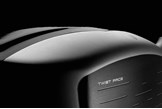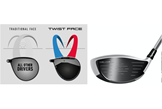Twist Face: TaylorMade’s new technology explained
Published: Last updated:
TaylorMade have introduced a brand new face technology in to their 2018 M3 and M4 Drivers; Twist Face. But what is Twist-Face technology?
TaylorMade has had some pretty huge innovations when it comes to drivers. They pioneered adjustability in the very first r7, they gave us speed pockets in the RBZ, and they even made a driver white. But they’re saying their new face technology for 2018 – which features on the all-new M3 and M4 drivers – is the biggest leap forward in driver face design for 130 years.
“Twist Face is a radical departure from traditional driver-face design,” says Brian Bazzel, Vice President, Product Creation. “It’s engineered to correct inherent human swing tendencies in real-time, giving golfers a tangible competitive advantage.”
Sounds exciting – but what exactly is Twist Face? Well, after studying half-a-million of shots from a vast range of players, TaylorMade discovered our most common driver misses result from high-toe and low-heel impacts.
To counteract the high-toe miss (a hook), the driver face has been “twisted” open – loft increased, face opened – high on the toe to help straighten ball flight. To counteract the low-heel miss (a slice) the face has been twisted closed, de-lofting and closing the face in the low heel area.
“The average high toe shot ends up eight yards left and spin really low,” adds Bazzel. “Same thing on a low heel impact – shots spin too much and end up on average six yards right; so 14 yards from high toe to low heel is the difference in the mean of all shots hit in those zones. If bulge and roll is working properly, those should be zero. With Twist Face, you’re going to go from 14 yards from low heel to high toe to essentially three yards. We talk about game changing innovations… this is where it’s at.”
Twist Face v a traditional bulge and roll
The face of every current driver is slightly curved. That curve from heel to toe (horizontal) is called bulge, while the curve from top to bottom is called roll. Bulge compensates for the spin on the ball imparted by off-centre hits. For instance, a shot hit off the toe will have left sidespin; bulge makes the ball start further right than a shot hit dead centre. Conversely, a heel shot will spin right; bulge makes it start left. Roll affects the loft of a shot depending on where the ball strikes the face.
A ball hit high on the face launches higher and spins less than a centre strike, while shots hit low on the face launch lower and spin more. By studying the performance of thousands of shots hit in each quadrant across the face whilst drivers were in the hands of real golfers (who unlike a test robot don’t always have a square swing path), TaylorMade worked out bulge and roll could be improved.
What happens to a Twist Face high toe shot
“This common shot spins really low and it ends up left of the target,” says Bazzel. “So we twisted the toe back, slightly open, to add a little more loft so shots go a little less left”.
Twist Face means these impacts have a bit more spin, stay in the air and go less far left. It’s the typical miss Dustin Johnson tries to avoid, by improving the result of DJ’s misses his confidence is higher so he can hit shots even harder.
What happens to a Twist Face low heel shot
“We’re trying to kill some of the spin,” added Bazzel, “so we de-lofted the face a little in this low heel area. This counteracts the shots golfers are hitting, not what a robot does. If you up the spin up a little on toe shots and reduce it on the heel, spin deviation across the face is going to much more consistent. The sweet spot is still centre.”
This is where Rory McIlroy typically misses with the driver, it’s a scary thought but by cutting spin we improve Rory’s accuracy, spin and distance deviation.
Click here to see if Twist Face actually works
Q+A BRIAN BAZELL; Vice President, Product Creation
How would you sum up Twist Face?
This is what we call our Mount Rushmore of innovations in TaylorMade drivers, going back to the original metalwood in 1979. We’ve broken tradition more than once, and we feel like Twist Face is deserving of being on that list. If you think about it, nothing has changed when it comes to driver face curvature for 130 years. Twist Face is an incredible breakthrough and one that will provide performance to all golfers.
What was the ‘eureka’ moment’?
The problem is with every golf company, and every driver that’s made, you bring heads in through the development cycle, you put them on a robot, you hit shots all over the face with the robot, and you create the right curvature to bring those shots back to the centre. The problem is that golfers don’t bring the face in square (the face angle relative to the path) every time they hit a drive. Golfers’ face angles change relative to the swing path, and because of that we see the problem that shots hit on the toe end up more left, and low heel shots end up right.
What are the main benefits?
We’re trying to counteract what’s happening in the head and the effect that’s created. With Twist Face, you’re going from 14 yards from low heel to high toe to essentially three yards. From a spin perspective, if you can increase the spin on that toe shot a little more and bring down the spin on the heel shot, your spin deviation across the face is going to much more consistent. You’re going to hit a lot more fairways.
Do you still need fitting?
Absolutely. This is not going to correct all swing flaws (and the M4 has a new weight track set-up)




